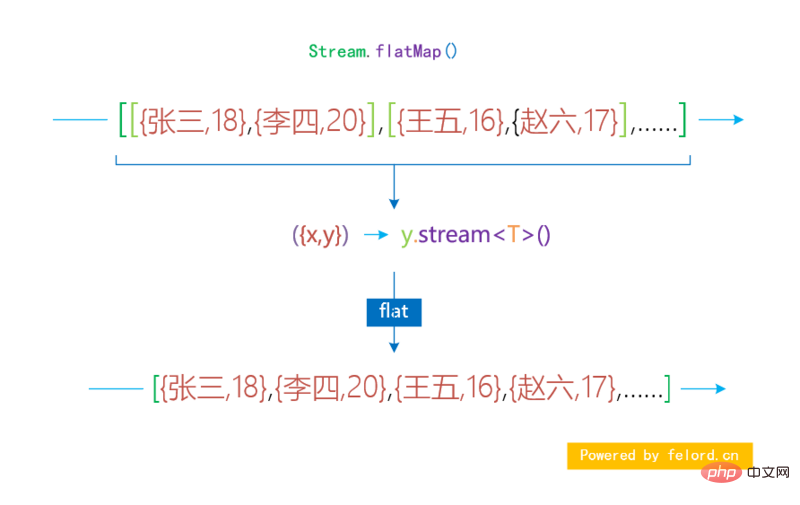Home >Java >Javagetting Started >Detailed explanation of map and flatMap operations in Java8 Stream Api

1. Preface
Java 8 provides a very easy-to-use Stream API. Collections can be easily manipulated. Today we will discuss two Stream intermediate operations map(Function super T, ? extends R> mapper) and flatMap(Function super T, ? extends Stream< ;? extends R>> mapper)
[Recommended learning: java video tutorial】
2. map operation
map The operation is to process the elements in the stream again to form a new stream. This is useful in development. For example, we have a student collection, from which we need to extract the age of the students to analyze the age distribution curve of the students.
Place before Java 8 We need to create a new collection and then consume the age attribute in the element by traversing the student collection. Now we have completed this requirement through a very simple streaming operation.
Schematic diagram:

Corresponding pseudo code:
// 伪代码 List<integer> ages=studentList.stream().map(Student::getAge).collect(Collectors.toList());</integer>
3. flatMap operation
Through the above example, the map operation should be very easy to understand. So what does flatMap do? In this way, we change the above example. If it is based on class, extract the ages of all students in all classes to analyze the age distribution curve of students. Is it still feasible for us to use the above method at this time?
List<list>> studentGroup= gradeList.stream().map(Grade::getStudents).collect(Collectors.toList());</list>
Through the above operation, we can only get the collection of student collections in each class List<list>></list>. We also need nested loops to obtain the student's age data, which is very inconvenient. It would be much more convenient if we could return the collection of all students List<students></students>. That's right! flatMap It can be done!
// flatMap 提取 List<students> map 提取年龄 List<integer> ages = grades.stream().flatMap(grade -> grade.getStudents().stream()).map(Student::getAge).collect(Collectors.toList());</integer></students>
As shown in the pseudocode above, we use flatMap to bring all students together. Then use the map operation to extract the age. flatMap is different from map in that map only extracts attributes and puts them into a stream, while flatMap first extracts attributes and puts them into a smaller stream, and then puts all The streams are merged into one stream. There is a feeling of "gathering sand into a tower".
Draw another picture to deepen your understanding:

4. Summary
## Once you are familiar with#map operations and flatMap operations, you can solve some data flow operation problems very easily. To expand your knowledge, in fact, in Java 8, these two operations not only exist in Stream, but also in Optional, and their functions are similar.
java introduction column, welcome to learn!
The above is the detailed content of Detailed explanation of map and flatMap operations in Java8 Stream Api. For more information, please follow other related articles on the PHP Chinese website!